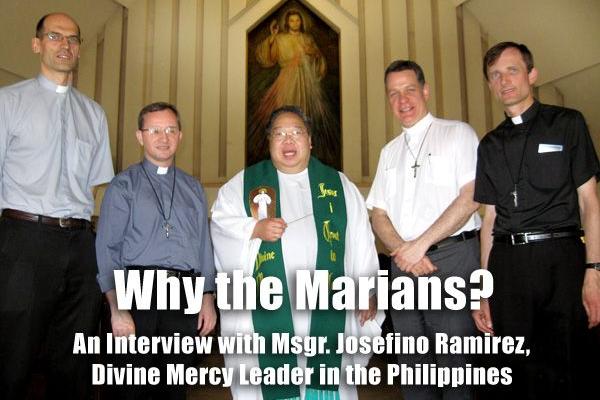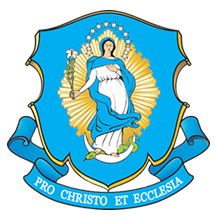
The following is an interview with Msgr. Josefino S. Ramirez, vicar general of the Archdiocese of Manila and director of the Divine Mercy Apostolate of the Philippines. Recognizing that the Marians have been official promoters of the authentic Divine Mercy message since 1941, Msgr. Ramirez invited the Marians to have a physical presence in the Philippines. The Marians sent missionaries to the Philippines in June, 2008.
Why have you invited the Marians to set up a mission in the Philippines? And what do you hope to achieve by their presence?
The Marians of the Immaculate Conception have been instrumental in the spread of the devotion to The Divine Mercy, not only in the Philippines, but almost worldwide. They have the necessary theological, religious, scriptural, and pastoral background for the spread of the devotion and the Apostolate. I am sure there's so much help they can do, and through them, the Philippines can be more prepared to cope with the divine tasks ahead of us.
A concrete example will be our partnership for the Divine Mercy Center of Formation For Asia and Oceania [currently under development on the Island of Guimaras, under the direction of Msgr. Ramirez]. The Marians will do well to help us realize our plans for the operations of the Center. They will serve as chaplains and faculty.
The Eucharistic dimension in the vocation and mission of every Marian priest is very significant and relevant. They have been with me, too, in establishing the devotion to the Eucharist through their apostolate, the Eucharistic Apostles of The Divine Mercy. I consider this dimension very vital in our Catholic faith and likewise with regards to the Divine Mercy devotion.
Another thing, the Philippines is a "Marian" country. The Marian Helpers will never be strangers in a land so loved by Mary, the Mother of Mercy!
Why do you think the Divine Mercy message and devotion has been so popular in the Philippines?
Because of the simple faith of the Filipinos, akin to their national identity and character. Filipinos are simple, God-fearing, trustful, patient, loving, self-sacrificing, open, generous, and industrious, etc. We, as a people, are God fearing and submissive to God and His divine will. We are a country comprised mostly of Catholics who have learned to live their daily life in faith, imbued with a sense of God and His abiding presence, and who have a respect for the clergy and the hierarchical Church. Also, Marian devotion is very strong here.
Generally, the poor who, in their want or lack of basic necessities, will put their trust in Divine Providence and have a recognition of their weakness and limitation and need for God and others. They use their trustfulness in God's mercy as a source of strength and hope!
Would you please give a history of the Divine Mercy movement in the Philippines? How did it begin there?
Local accounts reveal that as early as 1958, some devotees got hold of the portrait of Jesus as King of Mercy printed in a one-page brochure with an account of the apparition to St. Faustina in Poland. It is believed that some U.S.-based Filipino migrants brought to the Philippines copies of the 1945 copyrighted, 35-page Novena Booklet "Recent Revelations On the Mercy of God Devotion including the Novena to the Mercy of God" [published by the Marians of the Immaculate Conception].
Local devotees grouped together and prayed the Novena prayers and the Chaplet of The Divine Mercy. They also reproduced the materials from the copies handed to them, and, with the permission of their parish priests, they formed prayer communities. Among them were a number of small groups in the metro Manila area, which now comprises the Archdiocese of Manila, Dioceses of Cubao, Novaliches, Caloocan, Antipolo, and Paranaque. The groups and the individual devotees promoted the devotion to other parts of the country, and that resulted in Divine Mercy's widespread popularity. Printed materials, prayer leaflets, and booklets were distributed nationwide while local devotees continued to group together in churches or homes to pray, to share, and to promote the devotion. Soon, the enthronement of The Divine Mercy Image became a frequent activity among communities.
In February 16, 1984, new copies of the Novena to The Divine Mercy were brought to my office as vicar general and chancellor of the Archdiocese of Manila, to which I granted Nihil Obstat and Imprimatur. The lay devotee by the name of Corazon Venezuela opened her Divine Mercy Supply Center, while other lay devotees and promoters - like Rey Gutierrez, Br. Boy Fider, and their prayer groups - spread the devotion nationwide.
Then, I initiated the first "Third Friday Meetings" among the Divine Mercy devotees in the Archdiocese of Manila. In Jan. 18, 1985, a third Friday, a life-size image of The Divine Mercy was officially enthroned at the San Miguel Pro-Cathedral, where I was also parish priest. The Most Rev. Mariano Gaviola, D.D., archbishop of the Archdiocese of Lipa, gave the first official endorsement to the devotion in Nov. 27, 1984. By April 14, 1985, the Feast of The Divine Mercy was celebrated in at least seven churches.
Then, a television broadcaster by the name of Don Emil de Castro got interested in the devotion and launched a nationwide prayer movement using the Chaplet of The Divine Mercy. He called it the 3 o' clock daily habit, and it was telecasted simultaneously in all local TV networks and various radio broadcasting systems. I wrote a letter addressed to all the church officials asking for prayers and support for the nationwide prayer while Don de Castro obtained the full support from the Federation of Broadcasters of the Philippines. Don also obtained the support of the Marians of the Immaculate Conception in Stockbridge, Mass., U.S.A. They sent us the needed materials for the propagation of The Divine Mercy message. I then provided all local bishops with an information kit for the propagation of the Divine Mercy message and devotion. Some of them affirmed the devotion and gave us their support.
His Eminence, the late Jaime L. Cardinal Sin issued his own endorsement in Oct. 12, 1985, mentioning the Papal Encyclical Dives in Misericordia ("Rich in Mercy") as the source of this inspiration and devotion.
The First Archdiocesan Convention of the Divine Mercy was held in Aug. 3-4, 1985, at the College of the Holy Spirit, in Mendiola. On Nov. 20-29, 1988, the Divine Mercy Apostolate of the Philippines was founded, and I became its spiritual director. In Nov. 9, 1989, I was granted permission and approval by the Archdiocese of Manila to create the first Divine Mercy Chapel, and I served as chaplain there to 8,000 urban poor families.
A series of national Divine Mercy conventions took place year after year. A certain Stanley Villavicencio, who propagated the Divine Mercy, after having been raised to life after three days being clinically dead, led a Divine Mercy crusade, which also gained endorsement from the bishops in the southern and western parts of the Philippine Islands.
The Divine Mercy devotees also participated actively during the visit of Pope John Paul II in the Philippines in January 1995. On Feb. 16, 1996, two Polish nuns from the Congregation of the Sisters of Our Lady of Mercy gifted us with an 18-foot image of The Divine Mercy from Poland, and this was enthroned in the Archdiocesan Shrine of The Divine Mercy, in Mandaluyong City, where I am presently serving as rector.
The Marians of the Immaculate Conception, with Fr. Seraphim Michalenko, MIC, Francis Bourdon [executive director of the Association of Marians Helpers], John Canavan [a Divine Mercy promoter in Australia] and Dr. Bryan Thatcher [director of Eucharistic Apostles of The Divine Mercy] also visited the Philippines for a series of talks.
The Archdiocesan and Diocesan Divine Mercy Apostolates continue to get established in 48 dioceses nationwide with the support of their bishops. Likewise, the Divine Mercy Apostolate of the Philippines has taken to heart the task of spiritual formation for the devotees nationwide.
What effect has the Divine Mercy message and devotion had on your country?
It has brought about renewed faith through the devotion; a deepened sense of God in His mercy; a sense of hope through the spiritual and corporal works of mercy; a new dimension of stewardship and loving service; compassion for the poor through mercy centers; and sensitivity to the needs of others.
In addition, it has brought about contrition, forgiveness, and reparation; gratitude, selflessness, and generosity; a proliferation of charitable services and social awareness through the corporal works of mercy; increased knowledge of what the Divine Mercy is all about and awareness of God's merciful love; and trustfulness in God, especially in dark moments with the present ills of the society.
What are your personal thoughts about the Marians you have met so far?
I have good memories and a cordial relationship with the Marians - and Marian Helpers - whom I have encountered here and abroad. They have always made themselves available to others. They are selfless and generous in the simplicity and humility of their hearts. Their ardent devotion and fervor is manifested in the urgency of their responses to the growing needs of our devotees. The Marian Congregation has never been huge in terms of numbers, yet they work a lot for the spread of the devotion to The Divine Mercy worldwide. I believe the Lord has deigned them to be instrumental in the spread of the devotion, and we pray they continue to reap vocations here in the Philippines and in Asia.
The Marians of the Immaculate Conception, by working for The Divine Mercy and being Marian and Eucharistic in nature and character, make The Divine Mercy spirituality and devotion truly dynamic - indeed, the hope for humankind!
I am happy and grateful for the encounters I have had with each of them. I consider them my friends, and I treasure the moments I have had with them. God is just as close to me when they are around!
















